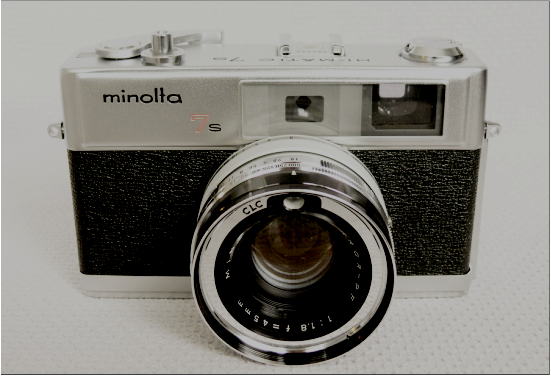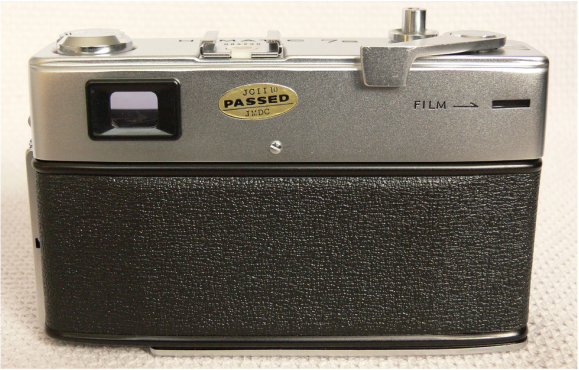|
1966 brought twin model introductions from Minolta that would lay the foundation for their next decade of rangefinder cameras. The nearly identical Hi-Matic 7s and 9 both featured Minolta's new CLC (Contrast Light Compensator) metering, which would serve as the top-of-the-line exposure measurement system for Minolta SLR and rangefinder cameras until the introduction of the AE-S Finder (1976) for the professional XK/XM SLR followed by the introduction of the enthusiast-oriented XD in 1977. Let's take a closer look at the Hi-Matics and the 7s in particular... A Harem of Hefty Hi-Matics The fixed-lens rangefinder served as the backbone of the consumer 35mm camera market in the 1960's. Most manufacturers had multiple offerings in this segment. Minolta debuted the original Hi-Matic in 1962 as its top-end fixed-lens rangefinder. (The Uniomats were their base models from 1960-65). All Hi-Matics featured at least one automatic exposure mode, either Shutter-priority or Program, and some (such as our subject, the 7s) also offered a fully manual mode. The Hi-Matic 7 added the following features: 1) a manual mode, 2) a new 45mm f/1.8 Rokkor lens instead of the 45mm f/2.8 of the original Hi-Matic, and 3) a cadmium sulphide (CdS) meter instead of the selenium meter of the Hi-Matic. The 7 would serve as the template both size and chassis-wise for the next three Hi-Matics: the 7s, 9, and 11. Sequels to Seven: 7s & 9 As stated at the outset, the Hi-Matic 7s & 9 came out in 1966, three years after the 7. Both had been improved with the new CLC metering and SLS (Safe Load System, bring on the acrynoms, Minolta ;-)) film loading. The differences between the two new models consisted of:
Features of the 7 that carried over in both successors were:
These specifications made the new Hi-Matics a formidable photographic duo in 1966. Using the 7s With the ability to offer both fully programmed and manual exposure, the 7s is a wonderful tool even today. The CLC metering is very accurate in most situations, with severe backlighting really being the only thing that will fool it. To deal with that, just pop into manual mode and you can easily compensate. The metering display is a little quirky in Hi-Matics, being expressed in EV (Exposure Value) numbers, which are a combination of shutter speed and aperture values. However, there is a handy EV window on the lens which you can read when setting aperture and shutter manually. With its 55mm filter ring and metering sensor located at the front of the lens, filter usage is painless on a 7s. Using a lens shade is highly recommended, as the 45/1.8 lens flares easily with its simpler coatings. A generic 55mm rubber hood costs a few dollars, and it can help keep good contrast in your photos. The 7s makes a fine street shooting machine, with its very quiet lens shutter and smooth winder. The winder does have a very long throw of 220 degrees, but is ratcheted so you can use multiple short strokes instead of one big loonngg one :-). So noise-wise the 7s is nice and inconspicuous. When it comes to size......not so much. The dimensions of the full-size Hi-Matics are just under those of an SRT. They are about 225 grams (8 oz.) lighter than the SLR with a 55mm f/1.7 lens mounted, though. So if you are the soul of discretion in your street shooting, you might want something smaller, like a Hi-Matic 7sII (1977). But if you like to engage your subjects, you could do a lot worse than having a gorgeous 7s in your hands ;-). Go in With Your Eyes Open :-) There are some things to watch for with any Hi-Matic. Many times the rangefinder and viewfinder windows become fogged (a common occurrence with most rangefinders of this vintage). Taking apart a 7s to clean these areas is not overly difficult if you have some experience with rangefinders, but it is VERY important not to mess up the alignment of the rangefinder (otherwise the camera will not focus properly). If this is something that you don't feel comfortable with, make sure you get a copy that is clean in the first place. Leaf shutters are another thing to watch for in any vintage rangefinder. Oil often migrates to the the shutter leaves and aperture blades and fouls them. Taking apart a fixed lens with a leaf shutter is not for the fainthearted. There are lots of tiny pieces that have to go in a specific sequence in order for the lens to function properly. Again, if you verify before you buy, you can save yourself a major headache :-). The final thing has to do with the meter, and this applies to the 7, 7s, 9, and 11: they all use the obsolete 625 mercury battery to power only the meter. The shutter is completely mechanical. If you're very fortunate, you may get a hold of a camera with that still has a viable mercury cell (they are very long-lived, particularly in storage). But if you don't, it's not the end of the world. You can obtain a C.R.I.S. MR-9 adapter which uses a smaller modern 386 silver-oxide cell and corrects its voltage output for the camera. If you don't want to go to that extent or expense, you can use your smartphone with a metering app, or good old Sunny 16. Sunny 16 is simply calculating exposure based off of an aperture setting of f/16 and the closest shutter speed to the reciprocal of your film's ISO speed (e.g. for ISO 200 film, a shutter speed of 1/250 sec) for bright sunny conditions. On a 7s that would equal an EV of 16 (easy to remember, eh?) which you can easily set via the EV window on the lens. You can use other combinations of aperture and shutter speed to get the same EV depending on the light conditions. Many people also use a 625 zinc air cell or 675 hearing aid battery with an 8mm o-ring to power the meter. Shorter life (3 or 4 months at best, usually) is the primary drawback of these options, but the low cost of 675 batteries in bulk packs of 6, 8, or 12 mitigates this to a large degree. Conclusion The Hi-Matic 7s and 9 were the high-water mark for full-size fixed-lens Minolta rangefinders. The Hi-Matic 11 of 1969 was a decontented version of the 7s & 9, lacking the manual mode and its control over aperture setting (it substituted a shutter priority mode instead), having a slowest shutter speed of 1/8 second, and a reduced ISO range of 25 - 500. The fully mechanical shutters and level of control available in the manual mode of the 7s & 9 makes for a pair of versatile cameras. And if you just want to focus and shoot, the reliability of the CLC metering ensures good exposures in most conditions. The high-end Minolta Hi-Matics offer one of the best vintage fixed-lens rangefinder experiences to be had :-). References: Minolta Hi-Matic 7 User Manual @ www.butkus.org/chinon/minolta.htm Minolta Hi-Matic 7s User Manual @ www.butkus.org/chinon/minolta.htm Minolta Hi-Matic 9 User Manual @ www.butkus.org/chinon/minolta.htm Minolta Hi-Matic 11 User Manual @ www.butkus.org/chinon/minolta.htm Minolta Technical Bulletin A @ http://www.rokkorfiles.com/Advertising/
2 Comments
1/25/2020 10:49:40 pm
Nice write-up and review of the Hi-Matic 7s! I just got one of them at the beginning of the month. It's a nice camera. I've taken a couple rolls so far, and have been impressed with the results--at least, on the pics I haven't screwed up. Just need to get better with a rangefinder camera!
Reply
C.J. Odenbach
1/26/2020 09:07:29 am
Hey, we all have to start somewhere :-). Glad to hear you’re enjoying your 7s and thanks for commenting!
Reply
Your comment will be posted after it is approved.
Leave a Reply. |
C.J. OdenbachSuffers from a quarter-century and counting film and manual focus SLR addiction. Has recently expanded into 1980's AF point and shoots, and (gack!) '90s SLRs. He even mixes in some digital. Definitely a sick man. Categories
All
Archives
June 2024
|


 RSS Feed
RSS Feed